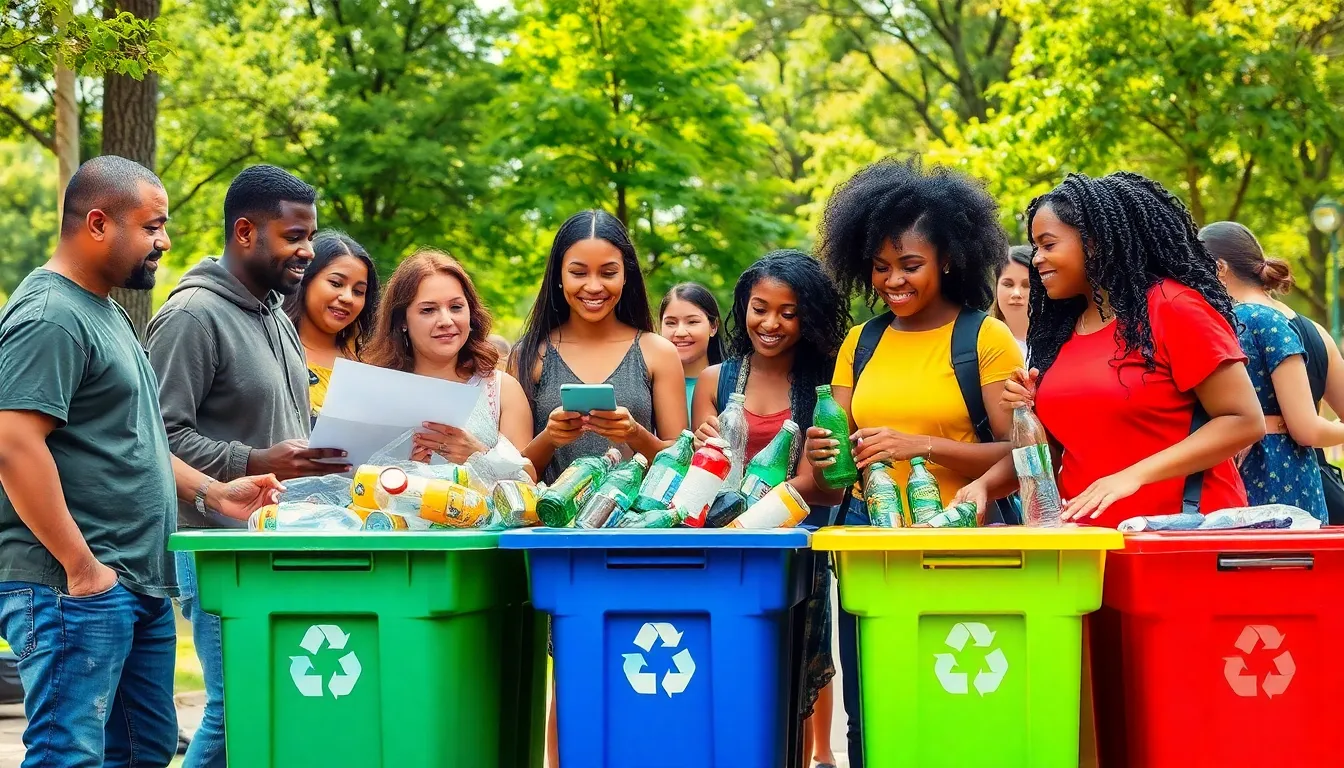In a world drowning in waste, recycled materials are the superheroes we didn’t know we needed. They swoop in to save the planet, transforming discarded items into valuable resources. Imagine turning yesterday’s soda cans into today’s trendy furniture or old plastic bottles into stylish clothing. It’s like giving trash a second chance at life, and who doesn’t love a good comeback story?
Not only do recycled materials help reduce landfill waste, but they also save energy and cut down on pollution. Plus, they can add a unique flair to any project. So, whether you’re a DIY enthusiast or just someone who appreciates a good pun about recycling, embracing these materials isn’t just smart—it’s downright exciting! Let’s dive into the world of recycled materials and discover how they’re reshaping our future, one quirky creation at a time.
Table of Contents
ToggleOverview of Recycled Materials
Recycled materials play a critical role in reducing environmental impact. These materials include paper, glass, metals, and plastics. The recycling process involves collecting, processing, and transforming discarded materials into new products. For instance, recycled plastic bottles can become fabrics used in clothing.
Transformations occur in various industries. Construction uses recycled concrete and metal to create new structures. Packaging often incorporates recycled materials to minimize waste. Many companies prioritize sustainability by sourcing recycled materials for their products.
Benefits extend beyond conservation. Energy savings significantly reduce manufacturing costs. According to the Environmental Protection Agency (EPA), recycling aluminum saves about 90% of the energy needed to create new aluminum from raw materials. Reductions in greenhouse gas emissions also contribute to a healthier planet.
In the creative sector, artisans and designers embrace recycled materials for unique projects. Clothing made from recycled plastics illustrates innovation in fashion. Likewise, furniture crafted from reclaimed wood showcases aesthetic appeal while supporting sustainability.
Challenges remain in the recycling process. Contamination poses a risk to recycling efficiency. Education on proper recycling methods helps mitigate this issue. Communities are strengthening efforts to improve recycling rates and promote awareness.
Overall, recycled materials offer an effective solution to the waste crisis while providing numerous benefits. Industries continue to explore their potential, highlighting the importance of innovation in sustainability efforts. By prioritizing recycled materials, society can make strides toward a more sustainable future.
Types of Recycled Materials

Recycled materials come in various forms, each playing a vital role in sustainability efforts. Understanding these types can enhance recycling practices globally.
Paper and Cardboard
Paper and cardboard consist of some of the most widely recycled materials. Collecting newspapers, boxes, and office paper allows for the creation of new paper products, reducing the need for virgin resources. Recycling one ton of paper can save up to 17 trees and significant amounts of water. Moreover, using recycled paper significantly cuts down on landfill waste.
Plastics
Plastics include a diverse range of materials, often identified by their resin codes. Recycling polyethylene terephthalate (PET) and high-density polyethylene (HDPE), common in bottles and containers, proves valuable. This process can convert plastic waste into new containers, clothing, or even building materials. Each recycled ton of plastic can save nearly 7.4 cubic yards of landfill space, demonstrating how addressing plastic waste aids environmental conservation.
Metals
Metals like aluminum and steel stand out for their high recyclability rates. Recycling aluminum saves about 90% of the energy used in producing new aluminum from raw ore. Each ton of recycled steel helps conserve natural resources, as it reduces the need for iron ore mining. Emphasizing metal recycling significantly decreases greenhouse gas emissions, supporting a cleaner environment.
Glass
Glass remains 100% recyclable, meaning it can be recycled endlessly without loss of quality. Collecting glass bottles and jars supports the creation of new glass products. Recycling one ton of glass prevents approximately 1,000 kilograms of carbon dioxide emissions. Additionally, turning glass waste into new bottles saves around 30% energy compared to producing glass from raw materials, enhancing overall energy efficiency in production.
Benefits of Using Recycled Materials
Recycled materials offer numerous advantages across environmental, economic, and social dimensions. Recognizing these benefits drives sustainable practices.
Environmental Impact
Environmental benefits significantly result from using recycled materials. Landfill waste decreases, contributing to healthier ecosystems. For instance, recycling one ton of paper saves up to 17 trees, showcasing its importance in preserving forests. Energy conservation emerges as another vital advantage; recycling aluminum saves about 90% of energy compared to new production processes. This energy savings leads to a substantial reduction in greenhouse gas emissions, which promotes a healthier planet. Overall, recycling materials contributes to pollution reduction and fosters a more sustainable environment.
Economic Advantages
Economic benefits of recycling manifest in various ways. Industries that incorporate recycled materials often experience lower production costs due to reduced raw material expenses. Recycling stimulates job creation, with over 1.1 million jobs in the recycling sector as of 2021. Investment in recycling infrastructure bolsters local economies and stimulates innovation. For example, manufacturers utilizing recycled plastics can produce high-quality products while saving money. Overall, the economic advantages of recycling materials promote healthy, sustainable growth in numerous industries.
Social Benefits
Social advantages linked to recycled materials directly affect communities. Awareness of sustainable practices increases, leading to a culture of environmental responsibility among individuals. Recycling initiatives often foster community engagement, bringing people together for clean-up events or educational workshops. Furthermore, artisans and designers inspire social change by using recycled materials in creative projects, showcasing sustainability in fashion and furniture. Through these efforts, recycling strengthens community bonds while promoting a shared commitment to environmental stewardship.
Challenges in Recycling
Recycling faces several challenges that impact its efficiency and effectiveness in reducing waste. Addressing these challenges is essential for enhancing recycling efforts.
Contamination Issues
Contamination is a significant barrier in the recycling process. When recyclable materials mix with non-recyclables, they compromise entire batches, leading to increased costs and waste. Examples include food residues on plastic containers or mixing types of plastics, which can disrupt processing. Educating the public on proper recycling habits is crucial to minimizing contamination. Communities are initiating educational programs to teach individuals about appropriate sorting methods. The aim is to increase overall recycling rates while improving material quality.
Market Demand
Market demand for recycled materials fluctuates, posing another challenge. Industries rely on stable demand for recycled content, yet price shifts can impact manufacturers’ willingness to use them. For instance, fluctuations in the oil market affect the price of virgin plastics, making new materials more attractive. Manufacturers often prioritize cost over sustainability when recycled materials become less economically viable. Awareness of the long-term benefits of investing in recycled content is essential to stabilize demand. Encouraging collaboration between municipalities and businesses can also bolster market stability.
Innovations in Recycled Materials
Innovations in recycled materials play a crucial role in driving sustainability forward. Companies increasingly focus on advanced technologies to enhance recycling processes. For example, new methods in sorting and processing improve material recovery rates, reducing contamination.
3D printing has emerged as a game changer, utilizing recycled plastics to create various products. Designers now experiment with these materials, transforming plastic waste into unique fashion pieces and furniture. Artisans showcase their creativity by incorporating recycled materials into artistic designs, echoing the demand for sustainable practices.
Additionally, bioplastics made from organic waste are gaining traction. These materials break down more easily than traditional plastics, minimizing landfill impact. Manufacturers benefit from lower production costs while contributing to environmental conservation.
Moreover, the construction industry embraces recycled materials to create greener buildings. Recycled concrete, glass, and metal are utilized in various structural applications. This practice not only conserves resources but also reduces the energy needed for new material production.
Studies show that switching to recycled aluminum can save up to 90% of energy compared to primary aluminum production. With this substantial energy savings, businesses find recycled options increasingly attractive. Communities benefit from job creation, with over 1.1 million jobs linked to the recycling sector in the U.S. alone.
Innovative projects emphasize the importance of awareness and education in recycling. Engaging local populations through workshops and programs fosters a culture of sustainability. As understanding grows, recycling rates rise, highlighting the significance of public support for recycling initiatives.
Embracing recycled materials is essential for creating a sustainable future. By transforming waste into valuable resources, society can significantly reduce environmental impact while promoting innovation across various industries. The benefits of recycling extend beyond waste reduction; they also foster economic growth and community engagement.
As technologies advance and awareness increases, the potential for recycled materials continues to expand. From eco-friendly fashion to sustainable construction, the possibilities are endless. A collective commitment to recycling and education can drive progress, ensuring that future generations inherit a healthier planet. Prioritizing recycled materials is not just a choice; it’s a necessity for a thriving, sustainable world.





